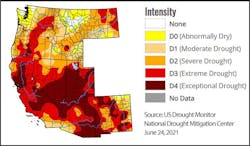Extreme heat and drought are bringing sharper scrutiny of data center water use, and testing assumptions about climate in some data center destinations. The heightened awareness of water constraints is raising the bar for fast-growing hyperscale computing specialist, as well as data center developers.
Data center water use was in the national media spotlight recently as NBC News took a critical look at cloud computing’s potential water use in regions facing severe drought. The story highlighted the enormous water used by some data center cooling technologies, as well as the efforts by some leading cloud builders to address worries that their facilities may compete with local residents for access to water.
The NBC story, which was also featured on business news channel CNBC, highlighted a new data center project in Mesa, Arizona which it said could require more than 1 million gallons of water per day. The proposal from Redale LLC was approved, with the lone dissenter, Vice Mayor Jenn Duff, saying “data centers are an irresponsible use of our water.” Duff cited a report that Arizona’s groundwater supply is being used too quickly, creating long-term risks to the water availability.
The debate in Mesa highlights the tensions between business and environmental concerns. Economic development officials in Mesa have actively courted data centers to locate in the Elliott Road Technology Corridor, where there are now 732 megawatts of data center capacity in the pipeline – even without the new project from Redale, which is working on behalf of a hyperscale operator planning 3 million square feet of capacity. Speculation on the end user’s identity is focused on Facebook, which is the only hyperscale operator without a presence in the Phoenix market.
Widening Drought Meets Record Heat
About 43 percent of the U.S. was experiencing drought conditions at the end of May, according to the National Drought Center. The Southwestern U.S. is currently facing a drought of historic proportions, as the region has experienced “abysmally low” precipitation, less than 50% of normal levels. Most of California and much of Arizona received less than 5% of their normal rain levels in May.
Meanwhile, an extreme heat wave has hit the Pacific Northwest, which has been a magnet for data center activity in recent years due to its cool climate, which allows the use of fresh air to cool servers, reducing the need for energy-intensive cooling systems using chillers.
Tuesday’s high temperature in Hillsboro, Oregon reached a record 113 degrees, more than 30 degrees above average. In Central Washington, temperatures hit 112 degrees in Wenatchee, which also saw a record ground temperature of 145 degrees.
Leading experts in climate and weather expressed particular alarm about Tuesday’s record temperature of 122 degrees F in Lytton, British Columbia, which was the hottest temperature ever recorded in Canada, and 8 degrees warmer than any temperature in the country prior to this week.
“This heatwave has reached further above historical means than any other summer heatwave previously recorded anywhere in North America,” said Dr. Robert Rohde, Chief Scientist at Berkeley Earth, an environmental research center, who called it a “stunning breakout far above all previously measured values.”
The extraordinary heat provides food for thought in data center site selection, where climate is a factor in determining the operating cost for a facility, including which cooling technologies will work best, and whether multiple approaches are needed to balance possible weather variations.
The History of Data Centers and Water Conservation
Water is not a new concern. I’ve been writing about the importance of water conservation in data center cooling since 2009, when the issue was highlighted by James Hamilton, the Amazon engineer and thought leader. As the data center industry has confronted its environmental responsibilities, water has too often been a secondary concern compared to electricity, a function of power’s more direct impact on carbon footprint.
In 2011, the data center industry consortium The Green Grid developed Water Usage Effectiveness (WUE), a sustainability metric to measure the amount of water used in data center cooling. In its early years the metric was lightly used compared to PUE (Power Usage Effectiveness), the Green Grid metric for energy efficiency.
That has begun to change in recent years, as changing weather patterns have raised awareness of how climate change may impact water availability. The profound drought in the Southeastern U.S and this week’s extreme heat in the Pacific Northwest have combined to place an exclamation point on the issue.
Data center operator’s sensitivity to water conservation was clearly seen in Microsoft’s recent announcement of its new cloud region in Phoenix, with Corporate VP of Cloud Operations Noelle Walsh emphasizing that “Microsoft’s Arizona datacenters will use zero water for cooling for more than half the year, leveraging a method called adiabatic cooling.” The company announced several other water-related initiatives:
- Microsoft is working with Gila River Water Storage to recharge and replenish groundwater levels in the Phoenix Active Management Area with long-term storage credits for the cities of Goodyear and El Mirage to balance a portion of Microsoft’s future water use.
- The company is working with the State of Arizona and the Colorado River Indian Tribes to sustain water levels in Lake Mead.
- Microsoft is working with The Yavapai-Apache Nation and The Nature Conservancy to convert flood irrigation to a pivot system on tribally owned lands, reducing the amount of water the Nation draws for irrigation and leaving more water in the Verde River system—without decreasing crop production.
Data center builders have used a variety of techniques to reduce their water use and community impact, including use of fresh air cooling and other low-impact cooling, and the use of recycled “grey” water systems, including municipal systems in places like Ashburn and San Antonio, and company-built water treatment plants (including a Microsoft site in Quincy, Wa. and Google campuses in Atlanta and Belgium). Immersion cooling technologies also offer the ability to use less water than some other approaches to cooling.
At DCF we’ve stepped up our coverage of water conservation over the past year. Here’s a look at some of the strategies and best practices presented in our stories, Voices of the Industry columns and special reports.
Tackling Data Center Water Usage Amid Historic Droughts, Wildfires: Data center water use has broad impacts. It affects the quality and availability of local water supplies, particularly when groundwater is involved. This special report series examines data center water usage amid historic droughts and wildfires in California and beyond.
How Aligned Saves 24 Million Gallons of Water A Year in Phoenix: This report from Aligned Energy, that outlines how the company installed a soft water program to its fluid cooler system at its Phoenix data center to save 24 million gallons of water a year.
Water Scarcity: How Data Centers Can Help: Kris Holla of Nortek Data Center Cooling and Michael Lesniak from Nalco Water discuss how data centers can conserve the planet’s diminishing fresh water supply and practice water stewardship.
Reduce Your Water Footprint Cost-Effectively: Three Tips for Data Centers: Cem Candir, CEO of Chemstar WATER, provides three tips for data centers looking for cost-effective ways to reduce their water footprint.
Making Your Data Center Water Positive: Additional insights from Chemstar WATER on new innovations in data center water treatment and how some hyperscalers are making their data centers water positive.
Focusing on Water Usage Effectiveness for Cooling Systems to Boost Sustainability: Miles Auvil from Trane Commercial HVAC highlights how focusing on water usage effectiveness for cooling solutions can ramp up sustainability.
New Data Center Cooling Methods to Tackle Water, Power Challenges: There are two major challenges facing the data industry today. A new report from Nortek describes these hurdles are finite water and power resources. A new white paper explores a new data center cooling method called the StatePoint Liquid Cooling (SPLC)4 system from Nortek Solutions, and highlights a case study in Singapore.






